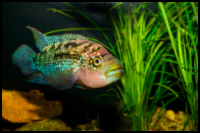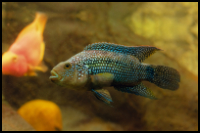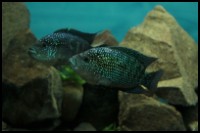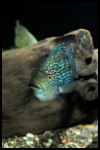





Quick Care Details (Table)
| Livestock Characteristics | Value |
|---|---|
| Care Level | Moderate |
| Temperament | Aggressive |
| Diet | Carnivore |
| Maximum Size | 10 Inches |
| Minimum Tank Size | 55 Gallons |
| Plant Safe | Yes |
| Temperature Range | 72-86F |
| PH Range | 6.5-7.5 |
| KH Range | 5-15 |
| GH Range | 8-12 |
Species Specific Categories
Helpful Video
Care Details
- Aquascape: Jack Dempsey Fish, a type of cichlid, thrive in environments that mimic their natural habitats, which include slow-moving waters with plenty of hiding spots. This is crucial for setting up your aquarium.
- Substrate: A mix of aquarium sand and crushed coral supports the natural behavior of a Jack Dempsey fish and helps maintain stable water pH levels in the tank.
- Disease Prevention: Common illnesses include Ich, or white spot disease. To treat this, raise the water temperature in your freshwater tank to 86 degrees.
- Filtration: A quality filtration system is essential for your aquarium due to the amount of waste Jack Dempsey cichlids produce.
- Lighting: Low to moderate lighting is best for Jack Dempseys in your aquarium.
- Water Flow: Jack Dempseys, like many cichlids, prefer slow-moving waters.
- Hardiness: These cichlids are very hardy freshwater fish and can survive warm water temperatures up to 86 degrees.
- Expected Lifespan: With proper care, Jack Dempsey fish can live up to 10-15 years in captivity.
- Special Requirements: theys are quite territorial and need a lot of space in the tank to prevent them from becoming aggressive.
document.getElementById("care-details-next-tab").addEventListener("click", function() {
document.getElementById("temperament-tab").click();
});
Temperament and Behavior
- Behavior: Jack Dempsey cichlids are known for their aggressive nature.
- Aggression: they are quite aggressive, especially towards tank mates.
- Tankmates Compatibility: Jack Dempseys require suitable tank mates and ample space in the aquarium to prevent territorial confrontations.
- Breeding: The Jack Dempsey is known to be egg layers and they breed quite easily in the aquarium setting. They are protective parents and will guard their eggs and fry fiercely.
- Activity Level: Jack Dempsey fish are quite active, especially when they are young. They tend to become more territorial and less active as they mature.
- Schooling or Shoaling Behavior: The Jack Dempsey fish are not schooling fish. They are quite territorial and prefer to have their own space.
- Plant Compatibility: You Jack Dempsey can be kept with plants, but they have been known to dig, which can uproot and damage delicate plants.
document.getElementById("temperament-next-tab").addEventListener("click", function() {
document.getElementById("diet-tab").click();
});
document.getElementById("temperament-previous-tab").addEventListener("click", function() {
document.getElementById("care-details-tab").click();
});
Diet and Nutrition
- Dry Foods: Jack Dempsey fish can be fed processed dried foods, including pellets and flakes.
- Frozen Foods: Frozen foods are part of the diet of Jack Dempsey cichlids.
- Live Foods: A Jack Dempseys fish can consume any animal that fits in its mouth, including small fish, worms, insects, and crustaceans.
- Feeding Schedule: Jack Dempsey fish should be fed 2–3 times per day.
- Vegetables: While Jack Dempseys primarily eat meaty foods, they can also eat blanched vegetables like peas and zucchini.
- Algae: a Jack Dempsey fish will not typically eat algae. They prefer meaty foods and some vegetables.
- Supplemental Foods: Supplemental foods like vitamin-enriched brine shrimp can help keep your Jack Dempsey healthy.
document.getElementById("diet-previous-tab").addEventListener("click", function() {
document.getElementById("temperament-tab").click();
});
document.getElementById("diet-next-tab").addEventListener("click", function() {
document.getElementById("tank-parameters-tab").click();
});
Tank Parameters
- Tank size: The minimum tank size for Jack Dempsey cichlids is 80 gallons.
- Water Temperature: The ideal temperature range for Jack Dempsey fish is between 72 to 86°F.
- Tank Length and Measurements: A tank for a Jack Dempsey should be at least 48 inches long to provide ample swimming space.
- pH (Acidity/Alkalinity): The ideal pH for a Jack Dempsey is between 6.5 and 8.0.
- KH (Carbonate Hardness): The Jack Dempsey fish prefer a KH of 5-12.
- GH (General Hardness): Your Jack Dempsey will prefers a GH of 8-12.
- Hardiness: Jack Dempsey fish are quite hardy and can tolerate a range of water conditions.
- Nitrate (NO3) levels: Nitrate levels should be kept below 50 mg/L, although below 25 mg/L is ideal for your Jack Dempsey fish.
document.getElementById("tank-parameters-previous-tab").addEventListener("click", function() {
document.getElementById("diet-tab").click();
});
History, Popularity, History and Species Variety Details
History of the Jack Dempsey Fish
The Jack Dempsey cichlid is named after the famous American boxer Jack Dempsey, who was the world heavyweight champion in the 1920s. The fish was given this name due to its aggressive nature and powerful appearance, reminiscent of the boxer's fierce personality and fighting spirit. The exact origins and history of the Jack Dempsey cichlid in the wild should be well-documented. Powerful They are native to the warm freshwater rivers, lakes, and ponds of Central America, mainly in Mexico and parts of Guatemala and Honduras. These regions reside in slow-moving or still waters with silt-like substrates and plenty of hiding spots among rocks, logs, and vegetation—the natural waterfalls along a neutral to acidic pH range due to the amount of rainfall. The Jack Dempsey cichlid gained popularity in the aquarium trade during the mid-20th century, even though we are sure people tried to keep these fish as pets long before. The hobbyists loved the visually striking and robust fish with vibrant colors and intriguing behavior. Since then, it has become a sought-after fish species for many aquarium enthusiasts due to its unique appearance and engaging personality. For years, hobbyists have conducted selective breeding efforts, which led to the development of various color morphs and strains within the Jack Dempsey cichlid. For example, we now have the electric blue Jack Dempsey. This electric blue Jack Dempsey displays beautiful black and blue colors. We also have gold, albino, and other color variations. These selectively bred strains have further enhanced the popularity and availability of the fish in the aquarium trade. Most are no longer taken from the wild; now, we aquaculture these fish. Today, the Jack Dempsey cichlid remains a favorite among cichlid enthusiasts and aquarists worldwide. Its striking appearance, robust nature, and exciting behaviors make it a captivating and rewarding species. The fish's historical connection to the legendary boxer adds an intriguing touch to its reputation, making it even more appealing to fans of fishkeeping and boxing history.
Male gender vs Female gender (Sexual Dimorphism)
Male and female Jack Dempsey fish have subtle differences, but it can be challenging to distinguish them visually. Males may exhibit more intense coloration, more significant fin extensions, and a slightly more elongated body shape than females. Males will also tend to be larger than females of the same age. The male's body would be more slender, but the females would be rounder and fuller. Behavior is also crucial but subtle. Males tend to be more aggressive, and females will be more submissive. This is easier to notice when placed in a tank with other jack Dempsey; when trying this with other fish species, you might have a hard time seeing the aggression differences. In some cases, examining the vent area (genital papilla) can provide clues for sex determination. However, this method requires experience and close observation, as the differences can be subtle. Breeding has been proven to work well in captivity and should be fun for a dedicated hobbyist.
Breeding the Jack Dempsey cichlid
You should have a freshwater aquarium setup for just one male and one female Dempsey. Having lots of cover and hiding spaces would be best to break down tank aggression. It would be best to have a cave in the tank where the female could feel safe enough to lay eggs. There should be only one entrance and one exit so that the female can guard the entry. It would be best if you conditioned both fish as best you can before placing them in the same tank, but you can do it while they are in the tank together. It would be best to condition them with lots of frozen and live fish food. They need to feel like food is abundant to ready them for breeding. The female will lay adhesive eggs on a clean, flat surface such as rocks, flowerpots, or other suitable substrates. The male will then follow the female to fertilize the eggs by releasing his milt over them. The female will take the lead in selecting the spawning site. After spawning, both parents play a role in caring for the eggs. They guard and fan the eggs to ensure oxygenation and prevent fungal growth. The parents may also move or rearrange the eggs to protect them from threats, but if you only have these two fish in the tank, that should not happen. The eggs typically hatch within a few days, and the fry becomes free-swimming shortly afterward. They can be fed with newly hatched brine shrimp, crushed flakes, or powdered fry food at this stage. The key here is to ensure what you put in there is small enough to fit in their mouth. If the tank is oversized, it won't be easy to target feed the fry. This will lead to likely over-feeding the tank with foods that might need to be more significant for the adult jack to get and too far away from the fry for them to find before it gets. You should check the tank parameters daily to avoid any spikes due to the likelihood of overfeeding. The parents will care for the children and try to guide them to food, but it is still likely that the fry will only get some of it. As the fry grows, it should be separated from the parents or moved to a grow-out tank to prevent predation and maintain optimal growth conditions. Provide appropriate tank setup, feeding, and maintenance to support the growth and development of the fry.
Variations of the Jack Dempsey Fish
Electric Blue Jack Dempsey: This is a widespread sub-species, which is slightly shorter in size and less aggressive and territorial than the main species12.
Pink or Electric Pink Jack Dempsey: The Pink Jack Dempsey is another rare breed, which is less aggressive than the original one
Gold Jack Dempsey: is a variant of the Jack Dempsey cichlid with a gold or light pink color. The most sought-after and attractive coloration of the bunch tends to be shades of gold.
Albino Jack Dempsey: is another variant. These fish have pink or orange bodies with pale yellow fins. However, these are not true albinos because they don’t have the signature red-colored eyes caused by the albino mutation. They appear to have a clear and spotless off-white to light-golden body, while some are also in light pink.
Personal Perspective
I believe Jack Dempsey is probably the most popular South American cichlid. They come in a few different color variations, but my personal favorite is the Electric Blue version. The main downside to the variation is that they live less than the naturally found Dempsey since these guys are heavily interbred to get their coloration.
I find that you can keep more than one tank as long as it is big enough with enough hardscape to carve out some good territories. I wouldn't keep more than one in a tank, but I would try mixing them with other South American cichlids since you definitely can't mix them with African cichlids.
I would also recommend making sure your tank is at least a 75-gallon tank, even if you get your cichlid at a small size since they tend to grow pretty fast. We all say we will upgrade next year, and then life happens, and we never get around to it.
So if you have a large aquarium in need of a tank boss, this guy might qualify as a top choice.
Frequently Asked Questions
Can I keep the Jack Dempsey with African Cichlids?
No, they have different habitat preferences and freshwater water parameters. Jack Dempsey fish prefers softer, acidic water but African Cichlids prefer harder more alkaline environment. So even though some water parameters might match up the PH requirements are far too different to workout long term.
Can I keep multiple Jack Dempsey Cichlid in a single fish tank?
Yes, but you must have a very large tank with lots of hardscape and vegetation. You should also try to keep only one male and the rest should be females. Expert aquarist have been able to keep multiple male Jack Dempsey in one aquarium, but this should be seen as the exception not the rule.
What are good tank mates for them?
Convict Cichlids, Fire mouth Cichlids, Severum Cichlids, Pleco, Ornate Bichir, Synodiontis Catfish, Silver Dollars, Rainbow fish, Bala Shark, Tinfoil Barb and many more. The key to keep in mind is that you need fast and large fish as tank mates in order avoid a Jack Dempseys aggression.
Are Jack Dempsey Cichlids mouth brooders?
No, but they do exhibit parental behaviors to care for their young.
Are they nocturnal?
No, they will be awake during the day and hide during the night times. If you notice your Jack Dempsey is not out during the day you might want to check and see if your fish is stressed and being picked on.
Will Jack Dempsey ever change colors?
Long term from the juvenal stage growing into adult stage these fish will gain more color especially if they are males. Jack Dempsey can also change colors when stressed to a darker color. This can happen if the fish is being picked on by a bigger fish or poor aquarium water parameters.
What substrate is best for a this cichlid?
Sand, Soil, or Gravel all work fine. You can even do a bare bottom tank if you are doing a quarantine.
How does a Jack Dempsey Fish Fight?
These fish are very territorial and will fight by ramming, biting, or flashing their fins. A little bit of aggression might not kill the other fish on the first fight, but if they continue to fight a fish might die because of extreme stress.
How often should I feed my Dempsey?
You can feed a Jack Dempsey once or twice a day. Pellets are very nutrient dense so if you feed cichlid pellets you don’t need to feed very much for the fish to meet it’s needs.
Will Jack Dempsey eat other fish in my aquarium?
They will absolutely eat another fish in your aquarium if it can fit in their mouth. If you have a fully grown Jack Dempsey, you should not have any fish smaller than 3 inches in the same tank.
Can I keep a Jack Dempsey in a community tank?
Yes, but keep in mind the fish needs to have comparable aquarium parameters and must be able to deal with a Jack Dempsey’s aggression.
Can a Jack Dempsey be kept alone in an aquarium?
Yes, they do not need other fish to live a fulfilling life.
How long is a Jack Dempsey’s life span?
Jack Dempsey have been recorded to live up to 25 years in captivity, but the average is around 15 years.

